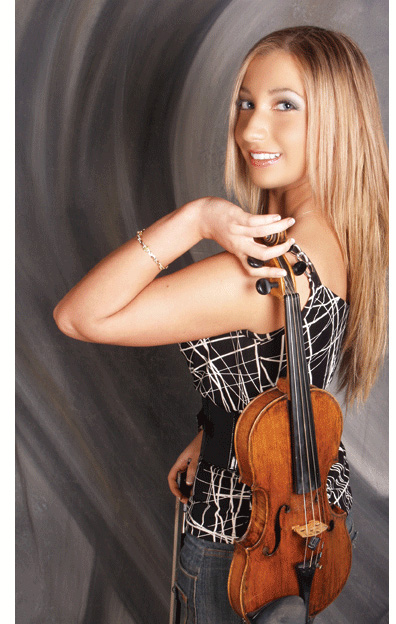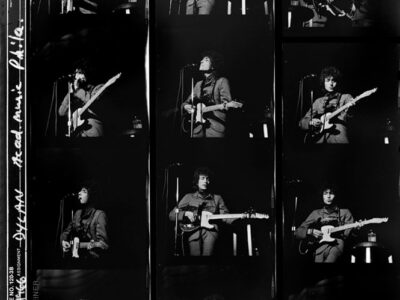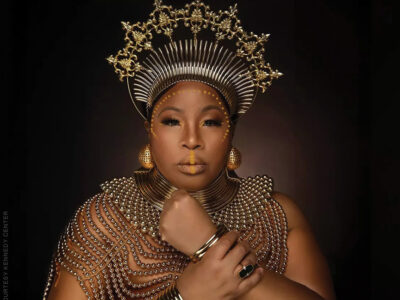A child prodigy grows up.
By Karen Rile

At an age when most aspiring classical violinists are picking out the repertoire for their senior college recitals, Ann Fontanella LPS’11 is already a seasoned professional, juggling the demands of a solo career along with her Penn classes. A former child prodigy who mastered the infamously difficult Tchaikovsky Violin Concerto at age six, Fontanella soloed with the Philadelphia Orchestra at 10, and made her debut in London’s prestigious Wigmore Hall at 17. Now 21, she is in her fifth year as a featured artist on the PennPAT (Pennsylvania Performing Arts on Tour) roster, giving recitals throughout the mid-Atlantic region, and is recording her second album.
Fontanella has long been noted for her virtuosic style, which combines a precise, lightning-fast left-hand technique with a bow-hold so atypical of modern violin-playing that her YouTube videos generate buzz on international violin-geek discussion boards.
“I use what my teacher called the ‘Russian Prodigy grip,’” explains Fontanella, a diminutive woman with perfect posture and a shiny blond ponytail who looks more like a gymnast or ballerina than a classical violinist with a powerhouse sound. Her unusual approach to the bow—straight pinky, high elbow—came about originally when she was a small girl, she adds. “I was six years old, and my quarter-size bow was just too long for me to get to the tip the conventional way. So I compensated, leaning to the left, in order to get a big sound.”
Fontanella points out that her bow grip is not unlike that of Jascha Heifetz, who began learning at the age of three with an oversized instrument, back in the years before the mass production of tiny Suzuki violins. While she was growing up, each of Fontanella’s teachers tried briefly to change her bow-grip to the Franco-Belgian (or “Galamian”) style currently favored by most contemporary players, but to no avail. Even as a small girl, Fontanella was set in her ways. She knew exactly the sound she was after, and how to achieve it.
“Everyone has a quirk,” she says. “It just needs to be a quirk that works for you. As it turns out, my sound is bigger and more focused this way. As violinists say, I play more ‘into the string.’” Fontanella, whose natural abilities have been often compared to those of Heifetz, has apparently not suffered for her unorthodox bow-grip. Her playing has been praised consistently by critics for its expressive tonal palette and trademark bel canto sound.
Fontanella practiced up to 10 hours daily throughout her childhood, but stresses that her early devotion to the instrument came as a labor of joy; she was never coerced by her non-musician parents, a Boeing engineer and psychologist, who home-schooled her and her three sisters. (All of her sisters studied music but chose professions in the sciences.)
“I just really like playing violin,” she says. “I used to do my schoolwork while practicing scales—with my textbooks propped on the music stand.”
An accomplished composer, Fontanella studied musical composition at Peabody Conservatory in Baltimore during her early teen years, and was a four-time winner of the prestigious Morton Gould award from the American Society of Composers, Authors, and Publishers (ASCAP).
Always a maverick, Fontanella wrapped up her high-school curriculum by the age of 14. After a year at the Yale School of Music, where she was the youngest-ever student in the undergraduate certificate program, she decided to eschew the conservatory route altogether. At 16, she enrolled in Penn’s former College of General Studies (now College of Liberal & Professional Studies) as a musicology major, taking two courses per semester in order to accommodate both her love of academics and the grueling practice sessions that eventually led to a mild case of scoliosis and chronic lower lumbar pain.
These days, however, she is the picture of health, a self-described fitness nut who limits herself to four practice-hours a day and enjoys playing in the Penn Baroque Ensemble for a change of pace. For musical guidance, she consults her private library of tapes, videos, and notes from almost six years of lessons with her late mentor, violinist Erick Friedman, who was one of Jascha Heifetz’s few students and is generally acknowledged as one of the great pedagogues of the 20th century. Friedman taught Fontanella privately at his studio from the age of 10, after she was introduced to him at master class.
“When we first met, Mr. Friedman told me that he would teach me because he was impressed with the way I dressed,” says Fontanella, laughing. “I was very fastidious at the time, with a slicked-back ponytail and a dressy blouse, very serious, not your typical 10-year-old.” Thus, after an almost chance encounter, Fontanella became the maestro’s youngest pupil (technically, Joshua Bell qualifies as the youngest, but his tenure at age seven was very brief) and his last. For the next several years Fontanella’s life revolved around weekly excursions to New Haven from her home in West Chester, Pennsylvania.
“When I was a little girl, Mr. Friedman used to say to me, ‘One day you’ll grow up and we’ll become friends,’” she recalls wistfully. But it wasn’t meant to be. Her final lesson was bedside, five years ago, only two days before Friedman’s untimely death from lung cancer at age 64. Fontanella then withdrew from the Yale program, certain that she would never find a mentor to replace him.
But she traces her violinist lineage directly to her mentor’s teachers, including Heifetz and Nathan Milstein, and to the so-called “Old Russian School” of violin-playing, a tradition she vows to help keep alive both through her performances and her educational mission. The latter includes private lessons at a music school in Exton, Pennsylvania, master classes, and her YouTube website.
“My approach to my future as a violinist is two-pronged,” says Fontanella, whose goal is to combine her skills as musicologist and performer, using both traditional and new media to grow as wide an audience as possible. As part of her proactive approach, she is currently producing her second CD, with “a Spanish theme.” (Her debut album, Bach, Schubert, Bruch, was released in 2005 to critical acclaim and has been re-issued through the independent artist website CD Baby.) She records both in the studio—using commercially licensed pre-recorded orchestra tracks to reduce costs and speed the process—and in live recital settings with collaborative pianists. Meanwhile, Fontanella is busy writing detailed educational commentaries on repertoire, music history, and performance style for her YouTube channel, where she cultivates an active fan base.
“Music makes the whole world a bit more appealing than what you’re living,” says Fontanella, who seems aware that by grooming her audience she is both preserving the tradition inherited from her mentor and laying the groundwork for her own future musical adventures.
Karen Rile C’80 teaches writing at Penn and is a frequent contributor to the Gazette.




